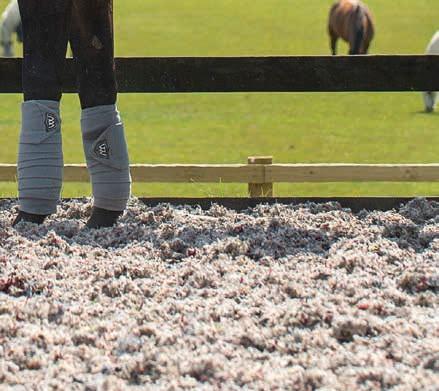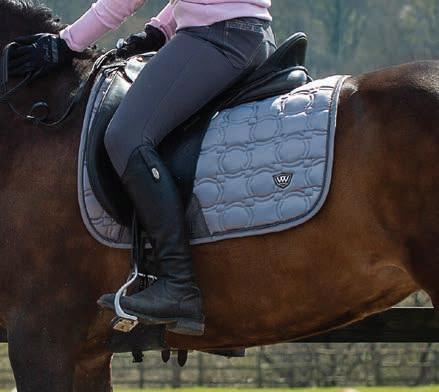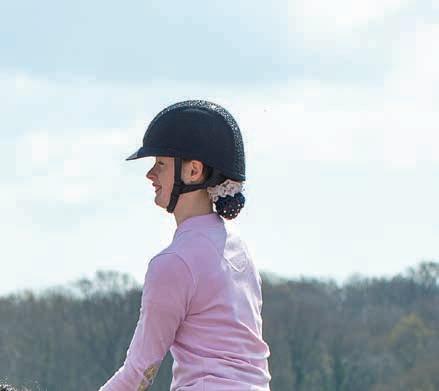







































































































































Whether you’ve nailed rein-back from the first part of our lateral work series or it’s still a work in progress, we’ve got another awesome move for you to try with your pony in your next schooling session. Find out what’s involved right here!
did you know?did you know?
All ponies are slightly stronger on one side of their body than the other, so you might find your pony finds it easier one way. Practising will help build up his suppleness and muscle tone equally on both sides.





Turn-on-the-forehand is a great exercise to start your schooling session. It will help your pony focus on what you’re asking, and you can check he’s responsive to your leg aid before you begin.



This is when you halt, then ask your pony to step sideways with his hindlegs so they move around in a circle while his forelegs stay still – sounds pretty cool, right?
Luckily, it’s not just a fancy dance move, either. There are plenty of reasons why it’s good for your pony to learn, including…
• building up lateral suppleness
• encouraging him to move away from your leg
• laying the foundations for more complicated lateral moves later on













With so many different parts to a cross-country course, all designed to test our skills, it’s no surprise that we face challenges in our rounds sometimes. Whether your pony dodges ditches or gets time faults for being too fast, knowing how to correct the issues you have will fine-tune your round and lead you to success.

Vittoria Panizzon is a top eventer who has represented Italy at three Olympic Games








Every pony has his own brain and individual personality. Some prefer to whizz around, leaving you struggling for control, while others back off fences when they find them scary. In some cases this can make them unpredictable and difficult to ride, and can lead to the three most common pony problems seen on the cross-country course. Here’s my tips to fix them...
When a pony spooks, his rhythm can change in the blink of an eye. So, the main things to think about are always keeping your shoulders back and your pony in a forward, positive rhythm. Work on his rhythm by counting the strides out loud or in your head, to help keep your pony focused on tackling the next part of the course, rather than thinking too much about what could be scary.
When it comes to jumping new fences, squeeze with both legs to keep your pony moving and be really encouraging with your voice, making sure you reward him, too.
If your pony’s prone to napping or running out, there’s one rule you to stick to – do the opposite of what he wants. For example, if he likes to drift right after a fence, while you’re out schooling always turn him left. If he runs out to the left, halt him as soon as possible, then turn him to the right. If your pony realises he can take control of a situation and get what he wants from it, he’ll be more inclined to do it. You need to kindly remind him that you’re the boss.

Going fast is some ponies’ forte but it’s not the safest way to tackle a cross-country course and will often leave you with pesky time faults! So, while XC schooling work on teaching him to not rush or pull.

As you approach each fence, ride a half-halt and then allow your pony to look at the jump by softening and lowering your hands. Avoid adjusting anything right before the jump. After the jump, sit tall and use your weight to slow him down until he’s stopped, then give him a pat and pick up trot again.
Taking your pony out in the horsebox or trailer can be really exciting – after all, it usually means you’re off on an awesome adventure! But whether it’s for a clinic, comp, hack or appointment, some ponies find travelling nerve-wracking – especially if they haven’t had much experience – so here are my tips to give yours confidence and help keep him safe.
Travel boots are designed to protect your pony’s legs from knocks and scrapes while he’s on the move – they’re made from tough, thick material that provides lots of padding. When fitting a boot…
1. Begin by holding it either side of the leg and slightly higher up than it needs to be.

2. Slide it down so the bottom of the boot is just above your pony’s coronet band.






3. Secure the boot with the middle strap first – this will



help keep it in the correct position.
4. Do up the other straps –make sure they’re tight enough to prevent the boot from slipping, but not too tight that will make it uncomfortable for your pony.

It’s as easy as that! If you’re worried your pony’s boots don’t fit him, ask your instructor or yard manager to check before the day of your journey. You don’t want to arrive and find they’ve slipped or rubbed him.

Check it
Did you know that travelling is hard work for your pony? He’ll use as much energy as he would if he was walking for the same amount of time! This means he’ll warm up so it’s a good idea to check the temperature and work out if he needs to wear a rug.
On a particularly chilly day, he might need a fleece on, but on warmer days, or if he’s travelling with a buddy, avoid putting a rug on him or he might get too hot and start sweating.

Did you know that ponies often lean back when travelling to help keep their balance? That’s why we use tail bandages and guards to protect their docks and tails from rubs!


Ask an adult for help applying the bandage as some ponies can hold their tails down, which makes it pretty tricky. If you’re having a go, stand to his side (not directly behind him) and, starting at the top of the tail, wrap the bandage round so it overlaps a little on each loop – then secure the Velcro or with a knot at the end. Next, put on a tail guard for maximum protection!


It’s super-important you don’t do the tail bandage or guard up too tight – you might affect his circulation, which will be painful.

